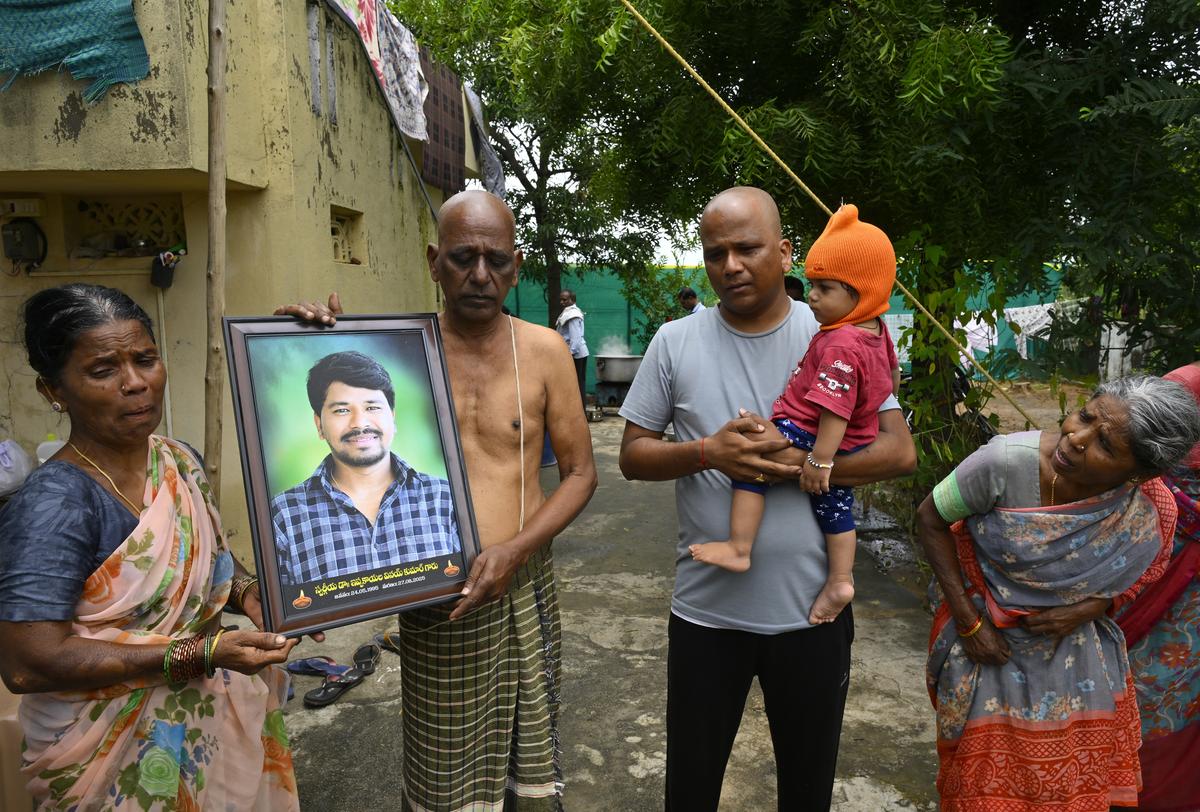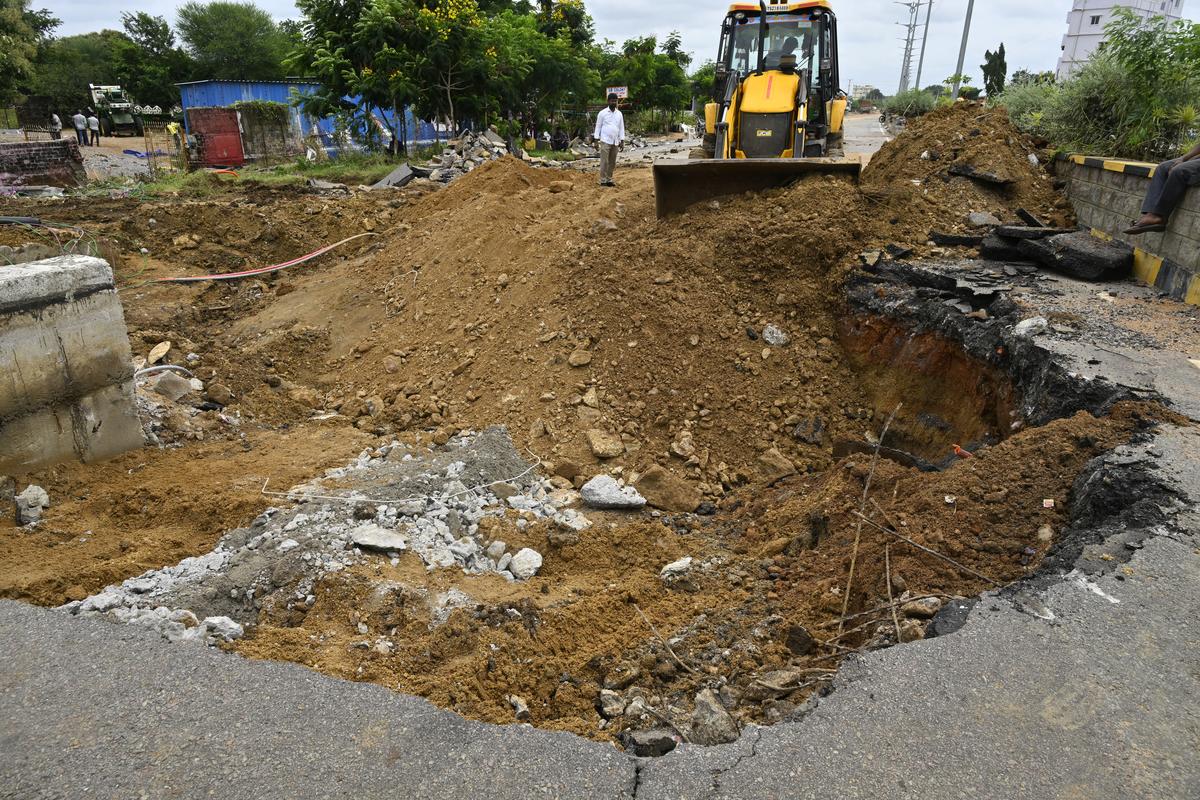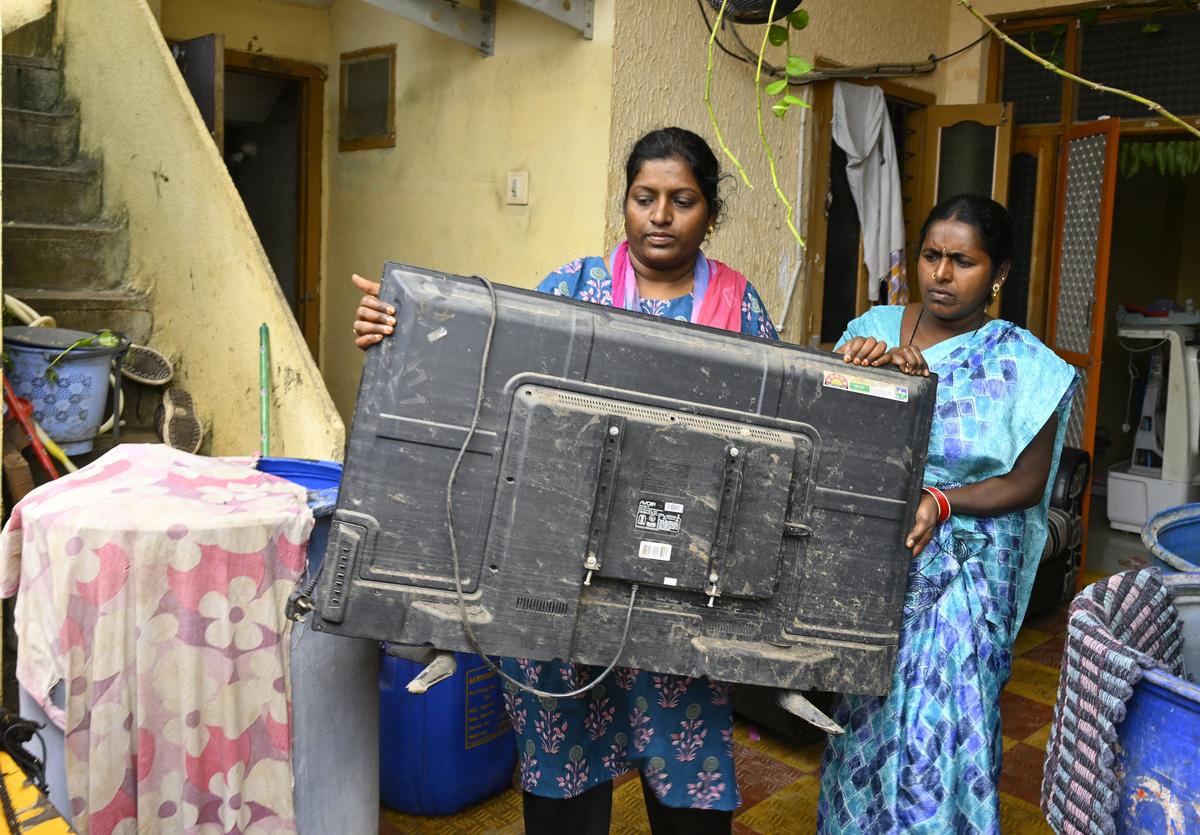The scent of incense lingered within the air, the sound of drums and chants rising, as residents of Goske Rajaiah (GR) Colony in Telangana’s Kamareddy city ready for Ganesh Chaturthi on August 27. Then, with out warning, the celebrations fell silent. By midday, the colony was unrecognisable, echoing with cries for assist.
“Every part modified in simply half-hour,” remembers Hajiwar Srinivas, president of the residents’ affiliation at GR Colony. Round 10.30 a.m., a livid surge of water from the overflowing Kamareddy Pedda Cheruvu burst into the colony from either side of the stream. By 11 a.m., each floor ground was below water. A morning of prayers had became a determined scramble for survival, as households clung to rooftops and higher flooring, watching helplessly whereas floodwaters swallowed their houses.
For 3 days — from August 27 to 29 — unprecedented rains battered Kamareddy city and district, submerging a number of colonies and villages. Households have been pressured to desert their homes and flee with no matter they may carry, as personnel of the Nationwide Catastrophe Response Drive (NDRF), State Catastrophe Response Drive (SDRF) and Emergency Providers Division, assisted by native volunteers, waded in for rescue.
To succeed in Kamareddy from the Nationwide Freeway-44, one should flip onto the previous freeway — a two-lane stretch main seven kilometres into the district headquarters, 110 km from State capital Hyderabad. It was right here, alongside the small stream, operating parallel to the bypass, that calamity struck. That Wednesday, the stream acquired flash floods so fierce that three colonies — GR Colony, Lecturers Colony, and Housing Board Colony — together with the ST Residential Faculty in Sarampalli, have been swallowed complete.

Inside minutes, floodwaters surged into streets and houses, forcing residents and schoolchildren alike to search for shelter on greater floor. Many remained trapped till 11.30 p.m., when rescuers lastly reached them.
The center-class residential pockets on either side of the bypass highway — house to Kamareddy’s 1.16 lakh inhabitants — bore the brunt. With most homes constructed as modest G+1 or G+2 constructions, the bottom flooring turned traps. Days later, worry nonetheless lingers. Even the sight of a cloudy sky is sufficient to ship shivers down the spines of residents.
“We’re vacating this rented house and shifting to a different colony close by. It’s not secure right here,” says L. Swaroopa of GR Colony, as she masses her belongings into an autorickshaw. Her household misplaced home equipment value almost ₹8 lakh — a tv set, laptop computer and furnishings. Their automobile was swept away and later discovered within the stream.

Her husband Nagaraju, a automobile mechanic, now repairs different flood-damaged automobiles without cost, whilst 4 of his personal shoppers’ automobiles lie ruined in his shed. “It is going to take not less than 5 to 6 years to get well from this loss,” she says, her voice heavy with despair.
Movies from that day present automobiles parked on the stream bund being tossed round like toys. In all, 18 automobiles have been reportedly washed away. Residents insist this devastation was not nature’s fury alone; they blame unchecked encroachments on the stream, which had drastically diminished its water-carrying capability. The 128-year-old tank overflowed, worsened by inflows from cloudburst-hit higher areas, and the excess course merely couldn’t maintain.
Chief Engineer (Irrigation) T. Srinivas admits the stream had been twice the culvert’s designed capability. Officers are actually analyzing the size of encroachments that will have choked the stream.
For 65-year-old grocery store proprietor Bondhugula Murali, the reminiscence is uncooked: “With three grandchildren, the youngest aged solely 13 months, we stood on the rooftop, ready for water and milk.”
Communication hole
His anger is directed on the lack of prior warning. Whereas the India Meteorological Division insists a crimson alert had been in place for twenty-four hours, State officers dismiss it as a “routine alert”, or too imprecise to set off ample preparedness.
Rescue groups finally made the distinction between life and loss of life. “Round 11 a.m., we acquired an alert about flooding in GR Colony,” says District Fireplace Officer (in-charge) S. Sandhanna. Station Fireplace Officer Abdul Salam and his group rushed in with rescue tenders, evacuating 240 folks to security with the assistance of personal earthmovers. Even when one rescue automobile overturned within the gushing waters, the employees managed to drag themselves, and others, out alive.

Members of the family of Ippakayala Vinay Kumar, a Mid-Stage Well being Supplier, who died when a compound wall collapsed on him at his residence in BC Colony of Rajampet village in Kamareddy district through the rains.
| Picture Credit score:
NAGARA GOPAL
Swift motion ensured that the toll didn’t spiral uncontrolled. “We might limit the loss of life toll to 4 solely due to well timed rescue operations,” says District Collector Ashish Sangwan. “With the assistance of NDRF, SDRF and emergency groups, 17 rescue missions have been carried out, saving 837 folks throughout the district, together with Kamareddy city.”
Officers detailed the size of the trouble: two NDRF items, six SDRF groups and 5 emergency response squads fanned out throughout 15 places. Among the many largest rescues have been 198 residents close to ESR Backyard in GR Colony, almost 300 youngsters and employees from the ST Residential Faculty and scores from Lecturers Colony, Housing Board Colony and several other inundated villages.
But tragedy was unavoidable. At Rajampet village, Ippakayala Vinay Kumar (28), a mid-level well being supplier working at Argonda Palle Dawakhana, died when a compound wall collapsed on him. “He was making an attempt to empty the floodwater by making a gap within the wall with a digging bar,” remembers his maternal uncle Naka Srinivas. “The wall gave means immediately, crushing him.”
Rajampet mandal was the worst hit by the rains, recording 71.82 cm rainfall in simply three days, accounting for 74.7% of its annual regular rainfall.
The district total was reeling too. “Kamareddy recorded 40.7% of its annual rainfall in simply three days,” Collector Sangwan notes.
In opposition to a traditional yearly common of 98.34 cm, the district was pounded with 39.98 cm from August 27 to 29. Roads caved in, crops perished, cattle have been misplaced, and several other cities and villages have been paralysed.
Report-shattering rain
The size of the deluge has already entered the file books. A number of mandals within the district logged greater than 300 mm of rain inside 48 hours, inserting the Kamareddy floods among the many State’s prime 30 historic occasions since 1900. Dhanya Bulla, founding father of Hyderabad-based FloodGuard Options, which works on constructing climate-resilient communities, calls it “the second highest in 120 years” by way of excessive rainfall unfold throughout a number of stations.
Numbers underline that declare. On August 27-28, Rajampet recorded 440 mm adopted by Nagireddypet at 335 mm, Kamareddy 334 mm, Sadasivanagar 319 mm, Lingampet 316 mm, Bikhanoor 330 mm and Tadwai 300 mm. Only a day earlier, Nagireddypet had acquired 247 mm rainfall, Yellareddy 253 mm, Lingampet 157 mm, Bhikanoor 170 mm and Rajampet 136 mm.
The 440 mm that Rajampet noticed in two days now ranks amongst Telangana’s prime 15 excessive rainfall occasions. However what makes it stand out just isn’t one freak downpour however a cluster of stations concurrently recording over 300 mm — a rarity within the State’s rainfall historical past.
It wasn’t a single-location excessive however a clustered excessive over Kamareddy and Medak districts, Dhanya observes.

Repairs being undertaken on the bypass highway close to GR Colony in Kamareddy after a portion of it was washed away within the downpour.
| Picture Credit score:
NAGARA GOPAL
A senior IMD scientist explains the meteorological cocktail that unleashed such fury: an eight-kilometre-high swirl of moisture from the Bay of Bengal collided with winds from the Arabian Sea over central Telangana. The outcome? A median of 30 cm rainfall poured over almost 1,000 sq. kilometres in a span of few hours. That interprets to 10.6 tmc ft of water crashing down, drowning cities and fields alike.
However whereas the IMD insists alerts have been issued, their public messages on social media appeared imprecise and routine, failing to flag the size of what was to come back.
The deluge left Kamareddy’s infrastructure in tatters. Officers have recognized 886 works requiring pressing or everlasting restoration. The invoice is staggering — ₹37.99 crore for non permanent fixes and ₹210.6 crore for everlasting repairs. The harm spans each sector: 157 irrigation tanks, 116 Roads & Buildings stretches, 122 Panchayat Raj roads, 242 faculties, 47 Well being Division buildings, 31 electrical energy installations and several other civic belongings throughout municipalities.
Agriculture, the district’s spine, was equally devastated. Floods swept via 334 villages, inundating almost 50,000 acres of standing crops. Preliminary surveys recorded 1,683 acres of losses, although officers warn the ultimate tally is perhaps far greater. Horticulture took a blow too — 140 acres have been affected, with almost a 3rd struggling harm past restoration.
“Two out of my three acres of paddy are gone,” says Dasari Bhumaiah from Polkampet village of Lingampet mandal, whose fields have been drowned after the Sardha cheruvu breached. In close by Lingampalli village, one other breach on the Mallaram tank flattened complete stretches of crop in a single day.
Haunting path of destruction
Houses and livestock weren’t spared. A complete of 1,225 homes have been broken, one in every of them utterly. Reduction help of ₹43.8 lakh has been sanctioned, but it surely does little to ease the loss. In animal husbandry, 108 cattle — cows, buffaloes, bulls, calves, sheep and goats — perished. Poultry farms have been hit hardest, shedding 47,570 birds within the floodwaters.
Electrical energy provide snapped in 38 villages however has since been restored. Non permanent patchwork has helped revive 113 broken culverts and 145 irrigation tanks, although everlasting rebuilding continues to be pending. Roads stay fractured and bridges washed out, chopping off entry to some hamlets. “Our precedence is restoring connectivity and guaranteeing provide of necessities,” Sangwan says, stressing that encroachments on stormwater drains and streams will now be cleared to permit free water stream.
The size of rainfall defies current reminiscence. Argonda station in Rajampet mandal alone clocked 44 cm. Throughout Telangana, 23 places — together with 10 in Kamareddy, 4 in Nirmal, six in Medak and the remainder in Nizamabad and Siddipet — recorded greater than 20 cm. It was the heaviest downpour in such a brief span prior to now 50 years.

Flood sufferer L. Swaroopa (left) from GR Colony in Kamareddy reveals the harm to her TV set after flash floods swept via the realm following heavy rainfall.
| Picture Credit score:
NAGARA GOPAL
Amid this chaos, SDRF groups carried out dangerous missions, rescuing 9 stranded staff at Boggu Gudise and 5 extra from Gunkal village.
Pocharam withstands file influx
Even century-old engineering was examined. On August 27, the 103-year-old Pocharam Mission in Nagireddy mandal confronted a file influx of 1.82 lakh cusecs, almost triple its designed capability of 70,000 cusecs. As water overtopped and the Kamareddy-side bund confirmed pressure, fears of a breach unfold. Officers later confirmed that the construction held agency as ranges receded.
In distinction, the Kalyani Medium Irrigation Mission in Yellareddy mandal was not as resilient — its gates gave means below the stress of swollen inflows.
Pocharam carries historical past in its stones. Constructed throughout the Allair river in Nagireddypet, it was the Hyderabad Nizam’s first irrigation undertaking, with its basis laid in 1917 and accomplished in 1922. As soon as designed to carry 2.423 tmc ft, siltation has diminished its storage to 1.82 tmc ft. Even immediately, its 1.7-km limestone bund, 58-km canal community, and 73 distributaries irrigate 10,500 acres whereas supplying consuming water to Kamareddy and Medak. That this relic of one other period withstood the flood fury was, for a lot of, a small miracle.
On September 4, Chief Minister A. Revanth Reddy toured the flood-hit areas of Kamareddy district. He inspected the Lingampalli Kurdu R&B Bridge, interacted with farmers in Budigida village whose fields have been blanketed with sand dunes and walked via the devastated lanes of GR Colony. On the Built-in District Workplace Complicated, he chaired a evaluation assembly with officers. However for households that watched crops vanish, cattle drown and their financial savings swirl away in muddy torrents, the flood was greater than a pure calamity; it was a reminder of how shortly life will be swept clear.

